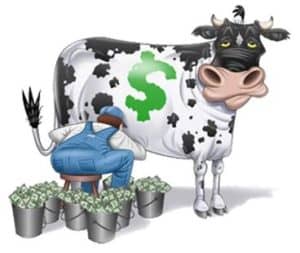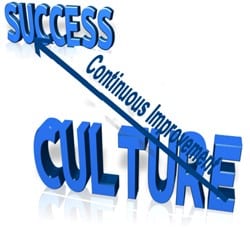Truss & Wall Panel Manufacturing a Cash Cow Division
 In the wood truss component industry, we have the independents, who are not associated with lumberyards, and then we have those who are owned by lumberyards. What I found striking is that the lumberyard owned and operated component manufacturers (CMs) consistently make far less money than the independently owned and operated CMs. Far too many lumberyards own unsuccessful CMs. These operations usually have a single digit net profit and are often considered to be a problem area for their company. However, the CM division should be a huge cash cow. When it comes to the CM net profit averages, it is common to make up 15%+ EBITDA in normal markets, in which the sales exceed a two-week lead time. Many independents garner in the 20+ EBITDA in good years. The main difference between the two is management philosophies and culture. If you want to garner better net profits, the best route is to embrace the lean manufacturing (LM) practices to create the environment that will result in better net profits.
In the wood truss component industry, we have the independents, who are not associated with lumberyards, and then we have those who are owned by lumberyards. What I found striking is that the lumberyard owned and operated component manufacturers (CMs) consistently make far less money than the independently owned and operated CMs. Far too many lumberyards own unsuccessful CMs. These operations usually have a single digit net profit and are often considered to be a problem area for their company. However, the CM division should be a huge cash cow. When it comes to the CM net profit averages, it is common to make up 15%+ EBITDA in normal markets, in which the sales exceed a two-week lead time. Many independents garner in the 20+ EBITDA in good years. The main difference between the two is management philosophies and culture. If you want to garner better net profits, the best route is to embrace the lean manufacturing (LM) practices to create the environment that will result in better net profits.
An anonymous former lumberyard CEO of 17 lumberyard locations explained to me that his two component manufacturing plants (CM) had made up only 10% of their sales yet contributed 30% of his net profits. He wished he had given the CM division far more focus and resources.
 LM practices should be thought of like a big toolbox filled with different tools to uncover and fix problem areas in your company. Better yet, LM helps you improve areas you did not know that could be improved upon. These important tools have names—5S, just-in-time, kaizen (continuous improvement) and much more. What is more important is the philosophy and culture change that happens within every organization. Most companies that fail to embrace LM do so because they truly cannot let go of their ingrained ways of thinking and management practices. Failure of implementing LM principles to garner real, positive results starts at the top and ends at the very bottom of the organization.
LM practices should be thought of like a big toolbox filled with different tools to uncover and fix problem areas in your company. Better yet, LM helps you improve areas you did not know that could be improved upon. These important tools have names—5S, just-in-time, kaizen (continuous improvement) and much more. What is more important is the philosophy and culture change that happens within every organization. Most companies that fail to embrace LM do so because they truly cannot let go of their ingrained ways of thinking and management practices. Failure of implementing LM principles to garner real, positive results starts at the top and ends at the very bottom of the organization.
 LM principles are more than your tools. LM changes the culture of the company because management and the employees are embracing continuous improvement in every area beyond the manufacturing. Every area such as employee retention, communication, management, training, sales and project processes are all constantly refined and improved for the company. In other words, you may not be able to use one of the coined LM terms, such as 5S, but your company can refine and improve a previously un-improvable area. A common example is when a company human resource department stands in the way of a needed pay scale change for the manufacturing group. Too often a company policy for the lumberyards may somehow be keeping the CM division from offering a pay scale adjustment or an incentive program. LM does not allow such short-sighted rulemaking to affect needed improvements.
LM principles are more than your tools. LM changes the culture of the company because management and the employees are embracing continuous improvement in every area beyond the manufacturing. Every area such as employee retention, communication, management, training, sales and project processes are all constantly refined and improved for the company. In other words, you may not be able to use one of the coined LM terms, such as 5S, but your company can refine and improve a previously un-improvable area. A common example is when a company human resource department stands in the way of a needed pay scale change for the manufacturing group. Too often a company policy for the lumberyards may somehow be keeping the CM division from offering a pay scale adjustment or an incentive program. LM does not allow such short-sighted rulemaking to affect needed improvements.
 Here is something that is not often stated openly about LM or the application of Six Sigma. (Six Sigma is an offshoot of LM.) These LM philosophies and practices, which include Six Sigma, apply common sense to overcome the egos that have been preventing needed changes. Six Sigma allows companies to display statistical data to prove or disprove a given idea for a particular area. An example is stated in the January 7th 2015 ProSales article, “US LBM uses technology and training to blaze its growth path.” The article shows how this company had great results because their mindsets were changed by LM. One example is rearranging the lumberyard so that trucks could be loaded quicker: “A redesign of facilities according to lean management techniques that, at one yard, have reduced forklift driving distances by 30% for most loads, improved traffic flow, and cut labor distribution costs as a percentage of yard revenue by 23%.” Does this seem like common sense? See link:
Here is something that is not often stated openly about LM or the application of Six Sigma. (Six Sigma is an offshoot of LM.) These LM philosophies and practices, which include Six Sigma, apply common sense to overcome the egos that have been preventing needed changes. Six Sigma allows companies to display statistical data to prove or disprove a given idea for a particular area. An example is stated in the January 7th 2015 ProSales article, “US LBM uses technology and training to blaze its growth path.” The article shows how this company had great results because their mindsets were changed by LM. One example is rearranging the lumberyard so that trucks could be loaded quicker: “A redesign of facilities according to lean management techniques that, at one yard, have reduced forklift driving distances by 30% for most loads, improved traffic flow, and cut labor distribution costs as a percentage of yard revenue by 23%.” Does this seem like common sense? See link:
http://www.prosalesmagazine.com/benchmarks/dealer-of-the-year/2015-dealer-of-the-year-us-lbm_o.
Component manufacturing should be a cash cow, making lumberyards increased net profits – unfortunately, most fall short. The failing net profits for most CMs are due primarily to company culture and management routines that inhibit the adoption of improved practices for that type of business. Embracing lean manufacturing philosophy and practices can help your company overcome common cultural and management routines and thereby help your group achieve much better returns.
If your group is thinking of improving or starting a new component operation, give TDC a call. TDC has proven time and again that we are the go-to experts at reducing cost and improving productivity in all departments of wood truss and wall panel manufacturing.
McCabe Lumber
Joe Tepe –Components – Division Manager, Co-Owner
Loveland, Ohio
McCabe
In recent years, the market for component manufacturing businesses has changed drastically. Our industry has become extremely competitive. The drop in construction has caused manufacturers to reduce prices as far as possible in order to “get the job.” During this time, we are forced to question our estimating techniques. We believe that a critical key to success is the ability to identify our true cost on every job that we estimate. We have to be aware of the point at which the job is no longer profitable.
Todd provided us with time standards which were specific to the equipment that we use. This information allowed us to estimate our jobs with a dramatically increased level of accuracy on each project, regardless of its level of complexity. The time standards also gave us the information to measure our production and establish target output for each workstation in our shop.
Todd also offered suggestions for lean manufacturing practices, marketing, quality control, production, and design incentives. We continue to implement his ideas, which have received positive feedback from our customers. Each has resulted in improvements to our operations.
I recommend Todd’s consultation to any truss manufacturer, even during this difficult market. The expense of the consult was money well spent in improving our profitability.
Todd Drummond Consulting LLC
Copyrights © 2002-2023 Todd-Drummond.com
Todd Drummond Consulting LLC
Copyrights © 2002 - 2021 Todd-Drummond.com
(603) 748-1051
todd@todd-drummond.com
www.linkedin.com/in/todrummond

